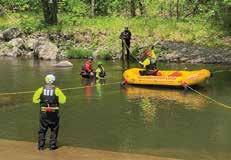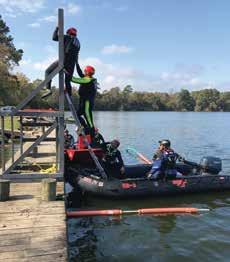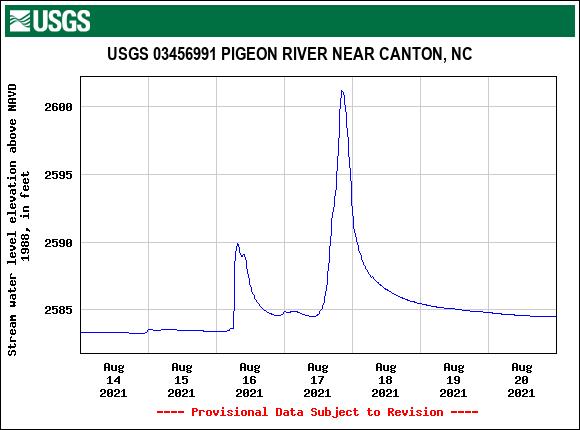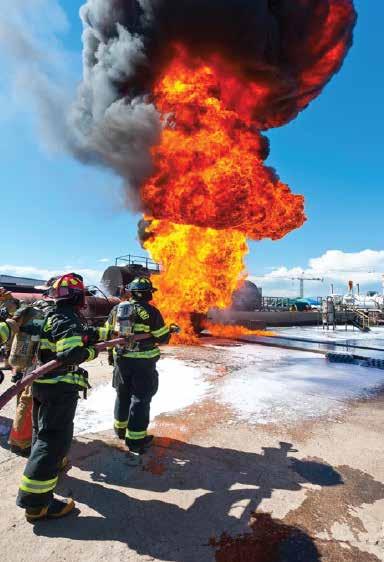
18 minute read
Starting and Staying Upstream
Tim Rogers, Ret. Battalion Chief, Charlotte Fire Dept.
The late medical sociologist Irving Zola once shared a parable that has had a profound impact on how I have come to approach swift water/ flood rescue training, program development, and response. It goes:
Advertisement
“I am standing by the shore of a swiftly flowing river and hear the cry of a drowning man. I jump into the cold waters. I fight against the strong current and force my way to the struggling man. I hold on hard and gradually pull him to shore. I lay him out on the bank and revive him with artificial respiration. Then, just when he begins to it. Simply waiting downstream with ten or so trained personnel was not going to work as we were serving a city with a history of flooding with over 700,000 citizens living among 18 water sheds with almost 3,000 miles of the open channel. Therefore, and with all that, I want to share some of the lessons learned and how you, along with your department or agency, can shift to an upstream swift water and flood response approach.
SOMETIMES IT RAINS TOO MUCH
Accept it! Sometimes in your community, it rains too much. When it does, all that rainfall program. Where does it flood? Why does it flood pluvial, fluvial, or tidal influence? What or who is impacted? What will be the capability and capacity of my organization and community to respond appropriately? What are my decision/action trigger points?
STARTING WITH WHERE AND WHY
History is still a great teacher, and there is plenty of available data and information regarding the southeast. The National Weather Service (NWS), the Federal Emergency Management Agency (FEMA) Flood Mapping System, your city or county storm-water management division, the South Carolina Floodplain Mapping Initiative (SCDNR), or the North Carolina Flood Risk Information System (NC FRIS) are just a few examples of where you can start to find out where it historically floods in your community. With just a few clicks on any of their websites, you can access volumes of information regarding the flood history and potential in your communities
Continued on page 10
Accept it! Sometimes in your community, it rains too much. When it does, all that rainfall can exceed the capacity of your geographical response area to absorb, contain, or discharge all the additional water.

breathe, I hear another cry for help.
Near exhaustion, it occurs to me that I’m so busy jumping in, pulling them to shore, and applying artificial respiration that I have no time to see who is upstream pushing them all in….”
For the last 30 years, I’ve been a student of and immersed myself in the swift water and flood rescue discipline. It all came about by happenstance. In 1992, my department was in the beginning stages of expanding its technical rescue capabilities, and I happened to be a part-time outdoor educator who spent a good bit of time as a raft guide. One of the program development team members heard about my river experience, and the rest is history.
However, it didn’t take long to figure out that if we didn’t build a program that took a “rescue ecosystem” and thus an upstream approach to swift water and flood emergencies and response, we’d always be spending our time in the figurative downstream and the reaction mode that Zola alludes to can exceed the capacity of your geographical response area to absorb, contain, or discharge all the additional water. Since one inch of rainfall can produce 17,378,560 gallons of water per square mile, it then comes down to rate, volume, and the aforementioned absorption, containment, and/or discharge capability of your geographical service area. Further, accept that once permeable areas are made impermeable due to paving and building construction, runoff from those areas can increase by as much as 80%. Thus, the normal containment and discharge capability of a stream, creek, or storm-water management system can be further and quickly compromised. The result of too much rain in either case! The additional water overtops its confines, and the banks expand toward a new lowest point and/or seek a new level. In other words, it floods.
Therefore, ask these five questions as you conduct your flood risk and response assessment, moving to an upstream approach as you develop your response

Photo Courtesy of Safe Rescue LLC
Since these rescuers from Harris County, Texas are often required to remove subjects from the upper floors of structures during flood incidents, their boat squad training includes scenarios that allow them to practice those skills.
Photo Courtesy of Safe Rescue LLC
An example of training, equipment, management, and personnel coming together to form a capable resource. The result is a successful and safe operation while using the four-point boat on tether technique.
S A F E R E S C U E . C O M

This USGS graph illustrates the value of knowing where to look for data for use to prepare for and respond to flood incidents. This graph shows the dramatic changes in CFS on the Pigeon River in Canton, during the flooding that occurred there on August 17, 2021. Graph Courtesy of USGS/Public Domain
“Where does it flood?” is one of the key assessment questions when planning for flood response operations. By sourcing historical “where” data, managers and responders can be better prepared
to address the “what is impacted” assessment element. Graph Courtesy of USGS/Public Domain Continued from page 8 down to your immediate response area.
How can you get “right now” information? In 1889 the United States Geological Survey (USGS) established its first stream gauge on the Rio Grande River in New Mexico. Since then, the stream gauge network has expanded to more than 10,000 sites in the United States. In 1995, the system was enhanced, and the network of stream gauges, and the vast network of rain gauges, can produce and make available data in real-time. Some of these sites include cameras that produce real-time images of the area.
While the USGS is not in the flood warning business, they are in the data collection and information business. By familiarizing yourself with the historical charts, graphs, pictures, and real-time data on their website platforms, you’ll be further armed with information to plan for and respond to flood emergencies even as the event unfolds. To access this valuable current and historical information, go to https://waterdata. usgs.gov and select your state.
Two other real-time web-based systems provide information and assistance to flood program planners, managers, and responders. Furthermore, both can be used as models for your community should you wish to develop a similar tool.
The first is the Flood Information and Notification System (FINS). Beginning in 1995, this system was developed in Mecklenburg County due to collaborative efforts between the USGS, the Charlotte-Mecklenburg Stormwater Division, and the Charlotte Fire Department (CFD). This system uses countrywide rainfall and stream data collected by the USGS and then continuously runs that data through program “rules,” which include elements such as stream rise, rainfall volume, and rainfall rate. From that, and in real-time, users are then provided with three levels of notification, or decision/action points, specific to an area being threatened alert, investigation, and emergency. This system has been referred to as “placing a smoke detector in the creek” and thus facilitates taking and maintaining an upstream approach to swift water and flood threats. The system includes several maps and information layers with the ability to focus on areas and specific properties that may be threatened. It is further enhanced by “creek cams” that allow users to take an immediate

look at areas that are the most prone to flooding and/or pose the greatest threat to citizens. The system is accessible to the public, and to do so, go to http://finslive. mecklenburgcountync.gov.
The second is the North Carolina Flood Inundation and Mapping Network (NCFIMAN). This interactive system utilizes the North Carolina statewide USGS stream and rain gauge network and offers some of the same tools as FINS. In addition, FIMAN offers further enhancements such as stream elevation, CFS flow, projected property damage, and impact projections. One of the most valuable enhancements of this program is the “scenario” feature that allows the user to purposefully increase the elevation of floodwater in an area and review the impact of such, all while being projected on a base map. This system is also accessible to the public, and to do so, go to https://fiman.nc.gov.
BUILDING THE CAPABILITY AND CAPACITY
Slim Ray and the late Jim Segerstrom are icons in the swift water and flood response rescue disciplines. In the early ‘90s, Slim stressed that emergency services must push resources into place before an anticipated event versus pulling, or trying to pull, resources into place once the event had begun to unfold. In other words, be ready as the event unfolds - get upstream. While the push modality has been generally accepted now, it met great resistance then.
However, what resources? What makes them capable? Which resources and how many do I need? As one of the founders of Rescue 3 International, Jim always stressed that a capable resource consisted of four maintainable elements training, equipment, management, and personnel. That model is still being used today, and it’s a great foundational tool to use. Think of it as the four legs to the “capability table.” While each leg would be further and exhaustively puzzled out, it comes down to the quality of
THE FOUR REALITIES
To further supplement the work done by Slim and Jim, I came to realize that flood incidents shared four specific characteristics. That is, floods, by their very nature, are multi-agency events, are multijurisdictional events, are Haz-Mat events, and are long-term effect events that can exhaust citizens and responders physically, mentally, and
each. For example, was the training conducted in a realistic swift water or flood environment that reflected your response challenges? Is the equipment appropriate for that environment, and has training been conducted? Who gets training, and at what level? What is the frequency of that training?
Over time, this model has evolved to address capability and risk. In other words, if I reduce the quality of the equipment leg by not maintaining or replacing such due to poor management, I decrease capability and increase risk. As a result, the overall capability is adversely affected since the elements are interdependent. emotionally. These have come to be known as the “four realities” in the industry and should be considered as you develop your program.
WHAT DO I NEED AND WHEN
While much work had been done about creating swift water or flood team typing models, little was done to develop and align the type of team with the anticipated response requirements. However, work is underway to create a template by which swift water and flood program managers can review potential response demands and then identify the type of team to best address them. (I’ve included a supplemental guide with this article that I’ve been working on that will hopefully help you determine your capability requirements based on the scope and size of potential or existing swift water or flood response.)
It starts with the current or anticipated area of operation in which the problem may occur. Essentially, is the area of operation a defined channel, and is the water still proximal to that channel and flowing in a defined direction despite increases in volume or velocity? These are referred to as Confined Area Rescue Operations (CARO) and think of such as your typical “river rescue” or “swift water rescue” response scenario. Conversely, if the channel and flow direction are no longer clearly defined, and expansion of the water is ongoing due to further increases in volume and velocity, this is referred to as Wide Area Rescue Operations (WARO).
Therefore, and in most cases, small, agile, lightly equipped teams can address CARO incidents, In contrast; WARO incidents may require the ability to conduct multiple ongoing operations over a large area- often referred to as response capacity.
TIME TO LEAVE THE EDDY
In closing, I want to the good folks at Carolina Fire Rescue EMS Journal for the opportunity to share this information with you. Hopefully, such will help as you now have some direction for looking for historical and existing swift water and flood data. Furthermore, you’re now armed with guidance as you work to develop or further maintain your swift water and flood rescue response capability so that you can start and stay upstream.
SUPPLEMENT TABLE

RESOURCE RESPONSE EXAMPLES FOR FLOOD AND SWIFTWATER INCIDENTS
Note: These resource response examples are not intended to prescribe how many resources should or could be used during a swift water or flood incident.
TYPE V OR IV INCIDENT RESPONSE
A typical Type V or Type IV would be considered a single incident and resource response to a localized flooding event and would consist of four to eight team members (squad, crew, or company or a combination thereof, for example), with at least two of those members possessing the Type I rescuer qualification. PPE would consist of a Type III or Type V PFD and helmet as a minimum, and thermal protection (dry suit/wet suit) would be utilized as needed.
Rescue techniques may include, but are not limited to, techniques such as talk, reach, throw, boat, and water entry. Simple rope systems such as a stabilization line or throw bags. Some shallow water crossing techniques could also be utilized during these events. Watercraft could be utilized as needed, and such is typically a river rescue board or paddle craft-such as an inflatable raft. Incident management would be self-contained, and any backup rescue system would be designed and implemented based on the event’s requirements.
Example: A fire department company with four personnel equipped with PFD(s), helmets, and throw-bags with at least two personnel trained in Type I qualification that responds to a single incident within their normal response area.
TYPE III INCIDENT RESPONSE
A typical Type III response would be considered a single incident/ location response by which the event conditions are more complex, may involve an area impacted by localized or wide-area flooding and may require more personnel, equipment, or resources. The response team would consist of at least 14 members, with at least seven at the Type I rescuer qualification level and a designated member to address each IC, safety, and logistical requirements. Each member would be equipped with a rescue belt equipped with Type V PFD, helmet, throw-bag, and thermal protection would most likely be utilized as a dry suit or wet suit. Rescue techniques may include, but are not limited to, talk, reach, throw, boat, or water entry with probably increased use of the latter two. More complex rope systems such as high lines or other systems require rope tensioning and/ or raising and lowering systems, which would most likely be utilized. Watercraft could be utilized as needed, including powered craft such as inshore rescue boats.
While incident management would be facilitated by a designated on-scene IC, that IC may be under the command or control of a larger incident management system. Furthermore, there would be a designated safety officer who would design, implement, and manage any backup rescue system based on the incident’s requirements, including decontamination of personnel and equipment after the incident.
Example: A 14-person mountain rescue team with at least seven members trained in the Type I qualification with a designated leader, safety officer, and logistics officer who has responded to an event inside or outside their normal response area. They would be equipped with rescue PFD(s), helmets; throw-bags; available thermal protection; and the required support equipment such as ropes, hardware, paddle craft, and/ or power boats.
TYPE II INCIDENT RESPONSE
A typical Type II response would be ongoing multiple incident/ location responses by which the event conditions are more complex, require more personnel, equipment, or resources, and may involve multi-day operations. This type of response may be required due to localized flooding in a single urban area, and such a response is required due to population density or incident complexity. This type of response may be required when the flood affects a wide area, including urban, suburban, and rural populations. This team may also be coordinating its activities with other teams or entities. It would likely be 21 members, with at least each member possessing the Type I rescuer qualification level. Designated members are serving as Task Force Leader (TFL/IC), safety, logistics, communications, and medical leadership qualify for those positions. Each member would be equipped with a rescue belt equipped with Type V PFD, helmet, throw-bag, communications, and drysuit thermal protection would most likely be utilized. Rescue techniques would include the ability to perform or facilitate, talk, reach, throw, boat, water entry, and helicopter with probably increased use of the latter three. More complex rope systems, such as high lines or other systems requiring rope tensioning and/or raising and lowering systems, would most likely be utilized. Watercraft would be utilized as needed, including powered craft such as inshore rescue boats. Such assets would be designated as boat squads. While incident management would be facilitated by a designated on-scene TFL/IC, that IC may be under the command or control of a larger incident management system.
Furthermore, there would be a designated safety officer who would design, implement, and manage any backup rescue system based on the requirements of the incident,

which includes decontamination of personnel and equipment after the incident. This team would operate from the identified FEMA swift water equipment cache for a Type I or Type II swift water or flood response team. It would be able to self-sustain its operations for a three to five-day period.
Example: A pre-identified trained and equipped team that is designated and rostered to respond to these incidents. Team membership may come from one or multiple agencies. safety, logistics, communications, and medical leadership would qualify for those positions. Each member would be equipped with a rescue belt equipped with Type V PFD, helmet, throwbag, communications, and dry suit thermal protection would most likely be utilized. Rescue techniques would include the

ability to perform or facilitate, talk, reach, throw, boat, water entry, and helicopter with probably increased use of the latter three. More complex rope systems such as high lines or other systems would most likely be utilized, requiring rope tensioning and/or raising and lowering systems.
Watercraft would be utilized as needed, including powered craft such as inshore rescue boats. Such assets would be designated as boat squads. While on-scene incident management would be facilitated by a designated on-scene TFL/IC,

TYPE I INCIDENT RESPONSE
A typical Type 1 response would be multiple incident/location responses to a wide area flood. The event conditions are more complex, may require more personnel, equipment, or resources, and may involve multi-day operations. This team may also be coordinating its activities with other teams or entities. It would likely be working from an Incident Action Plan and capable of sustaining day and night operations without interruption. The response team would have at least 36 members, each with a Type I rescuer qualification level. Designated members serving as TFL/IC,
[Type I Incident Response] rescue techniques would include the ability to perform or facilitate, talk, reach, throw, boat, water entry, and helicopter with probably increased use of the latter three.
any backup rescue system based on the incident’s requirements, including decontamination of personnel and equipment after the incident. This team would operate from the identified FEMA swift water equipment cache for a Type I or Type II swift water or flood response team. It would be able to self-sustain its operations for a three to five-day period.
Example: A pre-identified trained and equipped team that is designated and rostered to respond to these incidents. Team membership may come from one or multiple agencies.
that IC may be under the command or control of a larger incident management system.
Furthermore, there would be a designated safety officer who would design, implement, and manage Tim Rogers retired in 2020 as a Battalion Chief after 38 years of active and continuous service with the Charlotte Fire Department. At the time of his retirement, he was assigned to Battalion 5 of the Operations Division. He now concentrates his time as the Water Rescue Program Director for Safe Rescue LLC. He further serves as a Regional DirectorSoutheast, Steering Council Member, and Instructor Trainer for Rescue 3 International along with being a member of the Water Rescue Working Group for the International Technical Rescue Association.

• BIOEX Master Dealer • Large quantity of Foam in-stock in NC & SC! • Unbeatable Price • Fluorine-Free, PFAS-Free, and Environmentally friendly Since 2002!
Greenscreen Certified • Multi Purpose Class
A/B, Hydrocarbon, Polar
Solvents, and Aircraft











